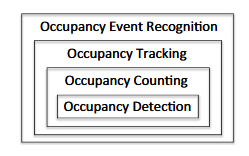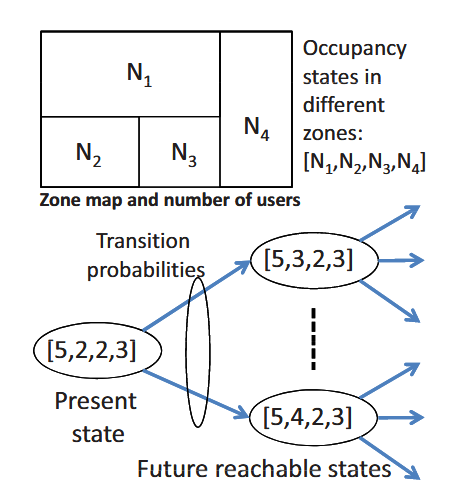ABSTRACT
With the proliferation of Internet of Things (IoT) devices such as smartphones, sensors, cameras, and RFIDs, it is possible to collect massive amount of data for localization and tracking of people within commercial buildings. Enabled by such occupancy monitoring capabilities, there are extensive opportunities for improving the energy consumption of buildings via smart HVAC control. In this respect, the major challenges we envision are 1) to achieve occupancy monitoring in a minimally intrusive way, e.g., using the existing infrastructure in the buildings and not requiring installation of any apps in the users’ smart devices, and 2) to develop effective data fusion techniques for improving occupancy monitoring accuracy using a multitude of sources.
This paper surveys the existing works on occupancy monitoring and multi-modal data fusion techniques for smart commercial buildings. The goal is to lay down a framework for future research to exploit the spatio-temporal data obtained from one or more of various IoT devices such as temperature sensors, surveillance cameras, and RFID tags that may be already in use in the buildings. A comparative analysis of existing approaches and future predictions for research challenges are also provided.
PROBLEM DEFINITIONS AND CLASSIFICATIONS

Fig.1: Occupancy monitoring problems
There are a number of variations when we refer to Occupancy Monitoring problem. These are interrelated but depending on the goal of the application, in the past, various forms of the problem are studied. We show them in the form of subset/superset relationships in Fig.1.
WI FI – BASED OCCUPANCY MONITORING
Most of the early building HVAC actuation systems are based on the occupancy data collected from sensors and cameras, which are deployed specifically for HVAC systems. Obviously, there is a major cost associated with the hardware, and the design, setup and maintenance of the data collection network. In this regard, Erickson et al. report an expense of $147 K for just the hardware for a three floor building, and wireless motion sensors are estimated to cost over $120 K for a five floor building test bed.
In addition to hardware cost, the inconvenience of deployment and the maintenance issues make it unattractive for commercial building owners to invest on the deployment of smart technologies for energy-efficiency purposes. Therefore, there is a research trend recently towards the use of existing communication infrastructure, such as the widely available WiFi AP infrastructure in buildings.
CAMERA – BASED MONITORING

Fig.2: Markov chain building occupancy model, with states represented by a sequence that holds the number of users in different zones
The multi-variate Gaussian model (MVGM) in (1), while takes into account temporal and inter-room correlations, does not account for previous user behavior, nor does it capture the information about the rarely used zones. In order to address these shortcomings, further introduces a Markov Chain model.
In particular, the states of the Markov chain are the occupancy at each zone ( [s1 , …, sm] for m zones), where the transition from one state to a different state depends only on 1) the current state, and 2) time (see Fig. 2). With L denoting the largest number of occupancy count in a zone, then, there may be a total of Lm states in the Markov chain, with many of the transition probabilities being equal to zero due to infeasibility to move between certain zones.
SENSOR-NETWORK BASED OCCUPANCY MONITORING
Indoor occupancy tracking accuracy can be improved significantly by using data fusion techniques to simultaneously utilize the information collected at different types of sensors, such as cameras, radio receivers, and occupancy detection sensors (CO2, PIR, etc.). In this section, data fusion techniques recently introduced in the literature in the context of occupancy monitoring will be briefly summarized.
A data fusion based occupancy monitoring technique that uses information from a variety of sensors is introduced in Each collection of sensor devices is integrated into an Arduino microcontroller with WiFi support, and they are mounted close to entrance door in a room at a height of 1.5m. For data fusion, a radial basis function (RBF) neural network is used at an Arduino device, which takes multiple sensory information as inputs, and outputs an occupancy count in a room, in the form of a number between 0−10.
COMPARATIVE ANALYSIS AND FUTURE PREDICTIONS
Table I summarizes the existing occupancy monitoring approaches in terms of the used infrastructure and techniques applied. The table indicates that most of the existing works relied heavily on sensor’s which need to be specially deployed. While different techniques are used based on artificial intelligence, machine learning and statistics, multi-modal data fusion was not applied in most of the works. Combination of WiFi, sensors, cameras and other resources at the same time was not investigated at all.
CONCLUSION
In this paper, we surveyed and analyzed the existing efforts for occupancy monitoring in smart buildings for energy- efficiency purposes. Specifically, we first identified the problem types that are related to people occupancy. We also discussed the past research that solely focused on using sensors and cameras. Finally, we investigated the current efforts where IoT comes into picture with the involvement of smart phones, motion sensors and WiFi APs.
The existing approaches indicated a trend towards the use of existing IoTs that are available within the buildings. With the goal of using minimal hardware and software costs, future smart buildings have a great potential to save energy by employing smart control strategies on HVAC through the help of data collected via IoT. We concluded the paper by identifying major future trends in this emerging area.
Source: University of Alabama
Authors: Kemal Akkaya | Ismail Guvenc | Ramazan Aygun | Nezih Pala | Abdullah Kadri
>> Latest RFID Based IoT Projects for Engineering Students
>> Top IoT Projects using Microcontroller for ECE Students
>> WiFi based IoT Projects for Engineering Students
>> 200+ IoT Led Projects for Final Year Students
>> IoT Software Projects for Engineering Students
